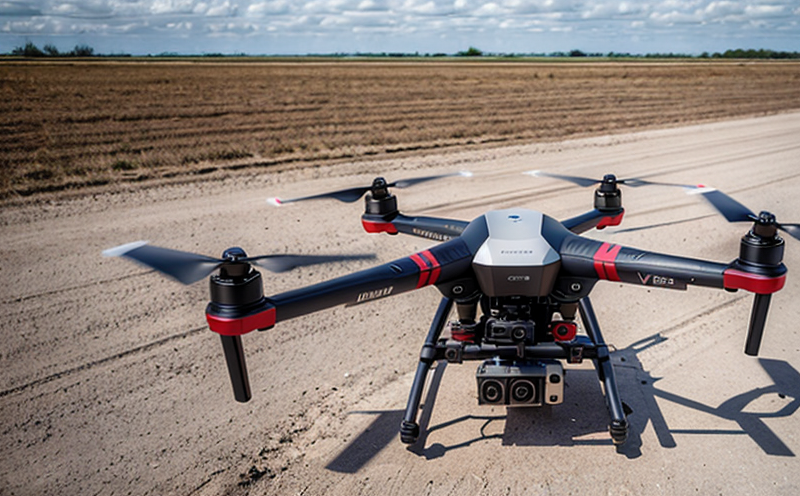ASTM F3520 UAV Parachute Recovery System Testing
The ASTM F3520 standard is a critical document for ensuring the safety and reliability of unmanned aerial vehicle (UAV) parachute recovery systems. This test procedure addresses the evaluation of parachutes used in drones, focusing on their deployment characteristics under various environmental conditions.
ASTM F3520-18 specifies the requirements, test methods, acceptance criteria, and reporting for UAV parachute recovery system performance testing. The standard is particularly important as it helps manufacturers, quality managers, compliance officers, and R&D engineers ensure that parachutes meet stringent safety standards before they are integrated into drones.
The testing procedure involves deploying a UAV equipped with the parachute from a specified altitude under controlled conditions to simulate real-world scenarios. The test aims to evaluate several critical parameters such as deployment time, deployment angle, stability, and overall performance of the parachute system. These factors are crucial in ensuring that the parachute can safely retrieve the drone after it has reached its operational limits or experienced an emergency situation.
For testing purposes, a specialized UAV is used, which includes sensors to measure various parameters during the deployment process. The data collected from these sensors provides detailed insights into how well the parachute performs under different conditions. This information is then used to assess compliance with ASTM F3520-18 requirements.
The scope of this testing extends beyond mere functionality; it also considers the environmental factors that could influence performance, such as wind speed and direction, temperature variations, and humidity levels. Compliance officers need to ensure that all these variables are accounted for during testing to accurately reflect real-world conditions.
Quality managers play a vital role in overseeing this process by ensuring that all aspects of the test adhere strictly to ASTM F3520-18 guidelines. R&D engineers contribute significantly by designing and refining parachute systems based on test results, while procurement specialists ensure that only high-quality materials are used in production.
The importance of ASTM F3520 UAV Parachute Recovery System Testing cannot be overstated. It provides a robust framework for assessing the safety and reliability of parachutes used in drones, ultimately contributing to enhanced public confidence in UAV technology.
- Ensures compliance with international standards
- Guarantees safe deployment under various conditions
- Maintains consistent quality across all parachute systems
- Promotes innovation and continuous improvement in drone design
In conclusion, ASTM F3520 UAV Parachute Recovery System Testing plays a pivotal role in ensuring the safety of UAVs. By adhering to this standard, manufacturers can build trust with consumers and regulators alike.
Applied Standards
The primary applied standards for ASTM F3520 UAV Parachute Recovery System Testing include:
- ASTM F3520-18: This is the latest version of the standard that sets forth requirements, test methods, acceptance criteria, and reporting procedures.
- ISO 9646:2005: International standards for parachute systems, which complement ASTM F3520 by providing additional insights into design considerations.
- IEC 61847-1: Pertains to the safety requirements for UAVs, offering a broader context within which ASTM F3520 operates.
These standards work together to provide comprehensive guidelines necessary for thorough testing and evaluation of UAV parachute recovery systems. Compliance with these standards ensures that manufacturers meet rigorous quality control measures and adhere to best practices in the industry.
Scope and Methodology
The scope of ASTM F3520 UAV Parachute Recovery System Testing encompasses several key areas:
- Deployment characteristics: This includes assessing how quickly and effectively a parachute deploys from a UAV under various conditions.
- Performance metrics: Measuring the stability, accuracy, and overall efficiency of the parachute during deployment.
- Environmental factors: Evaluating the impact of environmental variables such as wind speed, temperature, and humidity on parachute performance.
The methodology involves deploying a UAV equipped with an ASTM F3520-compliant parachute from a predetermined altitude. Sensors are used to monitor critical parameters throughout the deployment process. Data collected includes time-to-deployment, angle of deployment, stability during descent, and final landing position.
After each test run, the data is analyzed against established criteria set forth in ASTM F3520-18. If any parameter falls outside acceptable limits, adjustments are made to the parachute design or operational procedures until full compliance is achieved.
This rigorous testing process ensures that UAVs equipped with these parachutes can be relied upon for safe recovery operations even under challenging conditions. It also helps identify areas where improvements can be made to enhance performance and reliability further.





